
Towns & Villages to Visit
Below is a guide highlighting various towns and villages across the five provinces, each offering unique cultural and historical significance in Le Marche.
Video: Double portrait of the Dukes of Urbino by Piero della Francesca 1465-1472
Video: Ducal Palace (Ducal Palace, UNESCO world heritage site - Construction started in 1454)

Self Portrait (1504 - 1506)
Video: Biography of Raffaello Sanzio
Urbino, Province of Pesaro & Urbino (Click here for map)
The ancient city of Urbino, set in the rolling hills of the Marche, has a well-deserved reputation among cultured tourists in Italy. This is mainly because of the central role it played in the Renaissance.
Here, not only did some of the most astonishingly accomplished artists of the period live here (most notably the painter Raphael), but it also was a centre of financial power and political intrigue.
The renaissance architecture and artistic patrimony of the city is so well preserved that the historical town centre has been awarded the much-coveted title of Unesco World Heritage site.
It is a delight just to wander through the steep, narrow streets admiring the astonishing range of fine buildings and fascinating vistas.
The landscape is reminiscent of those landscapes painted by Raphael. It is a small city surrounded by golden sandstone walls, and is somewhat isolated from the main tourist routes as there is no access by rail or motorway, but there are regular bus services from Pesaro throughout the year, and, during the summer, from other tourist resorts on the coast. The climate is moderate, with summer temperatures averaging around 25 degrees, and the winter not falling much below 7.
The Ducal Palace - Home of the Duke and Duchess of Urbino
The overpowering feel of the place is 14th century, when the city came to its full glory under the rule of Federico da Montefeltro, who ruled here between 1442 and 1482.
He was extremely wealthy, an able diplomat, military strategist and a passionate patron of the arts, and commissioned a major restructuring of the city according to Renaissance principals: modernity, comfort, reason and beauty.
Data (the Duke’s stables, housing 300 horses), which has been recently reconstructed to its former glory.
His court glittered with genius: Piero Della Francesca was developing the science of perspective, Francesco di Giorgio Martini wrote a treatise on architecture, the father of the painter Raphael (Giovanni Santi) wrote a poetic account of the lives of the principal artists of the period. Castiglione, also, was part of this constellation, writing his political treatise ‘Il Cortegiano’ (the courtier) which introduced the idea of the European Gentleman. His court was the hub of Renaissance thought.
Il Palazzo Ducale (The Ducal Palace) is the first port of call on most tourist’s itinerary in Urbino, and is truly a magnificent building, even though almost all of the original decoration and commissioned artworks are no longer in situ. The beautifully decorated doorways and firplaces are a hint of the glories that would have been present in its heyday.
The most evocative part of the palace has to be the Duke’s private study, which is a small room built within the Duke’s apartment, decorated with intricately inlaind wood panelling and furnished in the authentic style.
This was reconstructed from sections found stored in underground storerooms. Unfortunately, the most famous painting of the Duke, by Piero della Francesca, is now in the Uffizi.
The building also houses the main art gallery of the Marche, (La Galleria nazionale delle Marche) which contains, amongst many other glories of the Renaissance, Della Francesca’s Flagellation of Christ and the Madonna of Senegallia, Raffaello's The Mute Woman; Giusto di Gand's Communion of the Apostles and Paolo Uccello's Miracle of the Host.
Another interesting feature of the Palace is the spiral ramp (La Rampa) leading to the Data (the Duke’s stables, housing 300 horses), which has been recently reconstructed to its former glory.
Home of Raffaello Sanzio, 1483 - 1520
The other essential destination for the cultural tourist is La Casa di Raffaello (Raphael’s House) which stands on the street of the same name. It is the birthplace of the famous renaissance painter Raffaello Sanzio whose father, Giovanni, was court painter to Duke Federico, and the house is a substantial building paying testament to his status.
It now houses a small museum. It has a very elegant interior and is little changed since the painter’s day. It has been kept fairly unadorned, with some copies of Raphael paintings on the walls, and some other minor artworks.
Raphael was born in this house in 1483 and is considered one of the trinity of ‘greats’ of the Renaissance, along with Leonardo Da Vinci and Michelangelo. His work is admired for its clarity of form, ease of composition, and the visual realisation of the Neoplatonic ideal of human grandeur..
A fascinating footnote to the history of the city is the extraordinary role it had during the second world war. After a tacit agreement with the allies and the Germans, a sign was painted on the roof of the Ducal Palace and the city suffered no bombings at all out of respect for the cultural value of the city and its heritage.
The superintendent of the art gallery invited others from around Italy to take advantage of this situation, and over 10,000 works of art were brought here and stored for the duration of the war in order to avoid Nazi requisition or destruction. These included works by Titian, Giorgione, Uccello, Raffaello and many more. There is also a tradition of ground-breaking architecture which extends up to the modern era, particularly with the collaboration of the local council and the University with the Genoese architect Giancarlo de Carlo beginning in 1956.
Several interesting projects have since been undertaken, including the internal restructuring of the Bonaventura Palace, several university faculties and colleges outside the city centre. The ‘centro storico’ (historical centre) was also salvaged after many years of neglect, during which time the area, and even the Ducal Palace, was at risk of collapsing because of ground subsidence. It is interesting to see how De Carlo has succeeded in successfully resolving the problem of introducing modernity into an historic setting.
Urbino hosts an international Festival of Early Music each year, and there is also a lively contemporary music scene.
There are many exciting festivals in Urbino throughout the year, most notably the Festa Del Duca (on the third weekend of August) in which the glorious Renaissance is recreated, and the Festa Dell’Aquilone (the first weekend in September) in which groups representing the local boroughs compete in jousts and other traditional sports. In the winter there is also the traditional Carnevale, with masked participants in traditional costume parading through the streets. There are also food and wine festivals where you can savour the wonderful local cheeses, wines and regional dishes.
Click here for more info about Raffaello Sanzio

Photography by Mariachiara Conte
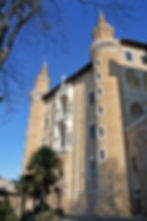
Photography by Mariachiara Conte
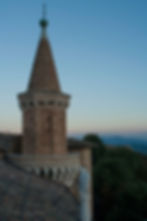
Photography by Mariachiara Conte
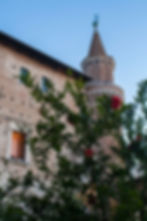
Photography by Mariachiara Conte

Photography by Mariachiara Conte

Photography by Mariachiara Conte

Photography by Mariachiara Conte

Photography by Mariachiara Conte

Photography by Mariachiara Conte
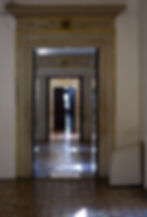
Photography by Mariachiara Conte

Photography by Mariachiara Conte

Photography by Mariachiara Conte
Pesaro, Province of Pesaro & Urbino (Click here for map)
Pesaro, an enchanting city along the Adriatic coast in Le Marche, boasts a rich history steeped in diverse cultural influences. Its origins trace back to ancient times, originally settled by the Piceni people and later becoming a vital Roman center known as Pisaurum. Throughout the centuries, Pesaro flourished under different rulers, experiencing the influences of Byzantine, Lombard, and Papal dominations.
The city's historical tapestry is woven with remarkable attractions. The Ducal Palace, an emblem of Pesaro's Renaissance glory, stands proudly, adorned with exquisite artworks and architectural splendor. The birthplace of Gioachino Rossini, the famed composer, now serves as a museum, celebrating his life and musical legacy. Alongside these treasures, Pesaro's picturesque coastline beckons visitors to its golden beaches, providing a delightful blend of history and seaside charm.
Cultural vibrancy fills the streets of Pesaro, with events and festivals celebrating its heritage. The Rossini Opera Festival, held annually, honors the city's most celebrated son and draws opera enthusiasts from around the world. The city's thriving art scene, showcased in galleries and exhibitions, adds to its cultural allure, inviting visitors to explore and immerse themselves in artistic expressions.
Moreover, Pesaro's gastronomy is a treat for the senses. Savory local dishes, especially seafood-based delicacies, offer a delectable taste of the region's culinary traditions. The fusion of history, culture, art, and flavors makes Pesaro an enticing destination along the Adriatic coast, inviting travelers to discover its multifaceted charm in the heart of Le Marche.
Fabriano, Province of Ancona (Click here for map)
Fabriano was founded in the early Middle Ages as a small Roman town 5 kilometres (3 mi) south of Attiggio (Latin Attidium). It’s main claim to fame is its long and continuing history of production of high class paper and techniques of watermarking. However, the little town holds other attractions for the tourist. The Cathedral, San Venanzio, is a glorious building, originating in the fourteenth century. We can still see the original polygonal apse and cloisters, and the chapel of St Lawrence (with frescoes by Allegretto di Nuzio) dated c.1360. There are also some frescoes from 1415 by the local painter, Giovanni di Corraduccio, entitled Stories of the True Cross.
The cathedral was rebuilt in the Baroque style between 1607-1617 and contains stucco decoration and canvases by some notable painters, including Orazio Gentileschi and Giovanni Francesco Guerrieri. The Palazzo del Podesta was built in 1255, but has been modified several times since then. It is in the form of a bridge because it originally spanned a stream which flowed through the town. The central arcade has frescoes from 13th and 14th centuries portraying warriors and a wheel of fortune supported by a female figure.
The Pinacoteca Civica Bruno Malajoli (Civic Art Gallery) is housed in an old hospital which was built in 1456. It is a marvellous building, and the collection, which was moved here in 1994, includes some wonderful paintings by, amongst many others, Allegretto Nuzi, Antonio da Fabriano, Bicci di Lorenzo, Neri di Bicci, Filippo da Verona, Domiziano Domiziani, Andrea Boscoli, Orazio Gentileschi, Francesco Podesti, and Gentile da Fabriano.
Another interesting collection is in the monumental complex of St. Benedetto, the Museum of Piano and Sound, with an exhibition of 18 pianos dating from the end of the 18th to the early 19th centuries. To experience the magic of a live show, you can buy tickets for the Teatro Gentile (Town Theatre), known and appreciated for its unique internal structure as well as excellent acoustics. It is considered one of the most beautiful and elegant theatres in Le Marche region.
The Paper Museum
Fabriano paper is famous worldwide for its quality. Production of paper of this quality took a long time to perfect, but by the second half of the 13th century the locally produced paper was already sought after all across Italy, and even in France and Spain. This was due not only to the product itself, but also to the skills of the merchants of the day in transporting and selling the paper, not to mention the geographical location, so close to the thriving port of Ancona. Many small artisan workshops were working on this industry in the early days in the long, arduous process of turning rag cloth into fine quality paper.
Their success was also one of the factors that led to the establishment in 1470 of one of the earliest printing centres in Italy in nearby Foligno in Umbria. The paper produced was of such a high standard that it was chosen by great artists such as Michelangelo and Titian for their work.
The present museum gives the visitor a fascinating insight into many aspects of the history of paper making and its significance in the renaissance world, and subsequently. The topic of watermarking is also important to the success of the product. Watermarks were originally used to identify the maker of the paper, and some can still be seen in the paper used for personal correspondence by many great artists, including Michelangelo.
The industry suffered a decline in the 17th and 18th centuries, but there was an upturn during the industrial revolution, mainly due to one entrepreneur, Pietro Miliani, who founded the Cartiere Miliani company, combining many small businesses in one. This family business was extremely successful, and continued until 2002 (even producing paper for the Euro bank notes!) when it was bought up by the Fedrigoni group.
In addition to the permanent collections, the museum gives practical demonstrations, as well as educational courses and workshops on a variety of skills, such as how to make paper using ancient manufacturing techniques, understanding the chemical peculiarities of lithographic printing, and inking and printing with an original press.
Jesi, Province of Ancona (Click here for map)
Jesi, an enchanting city nestled in the heart of Le Marche, boasts a rich tapestry of history and cultural significance. Founded by the Piceni, an ancient Italic tribe, Jesi flourished under Roman rule, becoming a vital municipality along crucial trade routes. Its significance grew during the Middle Ages when it emerged as a powerful free commune, experiencing periods of autonomy and prosperity.
The Renaissance marked Jesi's golden era, evident in its stunning architectural marvels. The Palazzo della Signoria, an epitome of Renaissance grandeur, stands proudly, showcasing exquisite craftsmanship and artistic brilliance. This period also saw the birth of the renowned composer Pergolesi, lending a cultural legacy to Jesi.
Jesi's main attractions reflect its historical and artistic prominence. The Palazzo della Signoria remains a highlight, displaying an impressive collection of art and historical significance. The Teatro Pergolesi, named in honor of the city's musical prodigy, serves as a cultural hub hosting concerts, performances, and exhibitions. Exploring Jesi's medieval walls and gates offers a glimpse into its defensive past while providing a scenic backdrop for discovery.
Cultural events and festivals animate Jesi's streets, celebrating its vibrant heritage. From art exhibitions to musical soirées, these events breathe life into the city, inviting visitors to immerse themselves in Jesi's artistic soul. Moreover, Jesi's gastronomy, featuring local delicacies and wines, complements its historical and cultural tapestry, inviting exploration and a taste of Le Marche's culinary excellence amid Jesi's captivating allure.
Ancona, Province of Ancona (Click here for map)
Ancona, the regional capital of Le Marche, stands as a testament to a rich history that spans millennia. Founded by Greek settlers, its name stems from the Greek word for "elbow," symbolizing its prominent location on a bend of the Adriatic coast. Ancona thrived under Roman rule, evolving into a vital port city, evident in iconic landmarks like the Arch of Trajan and the Roman Amphitheatre, which still bear witness to its ancient past.
Throughout the Middle Ages, Ancona endured various rulers, including Byzantines and Lombards, before becoming a prominent maritime republic. Its maritime influence expanded during the Renaissance, fostering a period of economic and cultural growth. Ancona's significance as a bustling port city grew, attracting merchants and artists, leaving a profound mark on its architecture and cultural heritage.
The city's main attractions embody its historical legacy and cultural richness. The Arch of Trajan stands as an enduring symbol of Roman grandeur, while the Cathedral of San Ciriaco, perched atop the Guasco Hill, offers panoramic views and showcases splendid Romanesque architecture. Ancona's historic center, with its winding streets and picturesque squares, invites exploration, revealing hidden gems like the Church of Santa Maria della Piazza and the elegant Mole Vanvitelliana, an 18th-century pentagonal fortress.
Ancona's charm extends beyond its historical sites. The city's vibrant cultural scene includes theaters, museums, and art galleries, fostering a dynamic atmosphere. Events such as the Summer Jamboree, celebrating vintage music and culture, and the Ancona Jazz Festival, attract visitors and locals alike, showcasing the city's eclectic artistic offerings. Ancona's culinary landscape, famed for its fresh seafood and regional specialties, complements its historical and cultural allure, inviting visitors to indulge in the flavors of Le Marche while immersing themselves in the captivating history of Ancona.
Macerata, Province of Macerata (Click here for map)
Macerata, a charming city nestled in Le Marche, boasts a captivating history dating back to Roman times. Founded as a strategic fortress town, it evolved into a significant center during the Middle Ages. Macerata's defining moment arrived with the establishment of its university in 1290, becoming a vital hub for education and cultural development in the region.
The Renaissance period further enriched Macerata's heritage, leaving an indelible mark on its architecture and intellectual vitality. The city's architectural marvels, such as the elegant Sferisterio Arena, symbolize its cultural prominence. This open-air arena hosts the annual Macerata Opera Festival, drawing enthusiasts from around the world to revel in exquisite performances against a breathtaking backdrop.
Macerata's main attractions reflect its historical and artistic prominence. The Sferisterio Arena stands out as a cultural gem, hosting world-class operatic events amidst an enchanting setting. The University of Macerata remains a focal point, preserving a legacy of academic excellence.
The city's vibrant cultural scene extends beyond the opera festival, embracing art exhibitions, theater productions, and musical performances. Macerata's culinary landscape, boasting regional delicacies and wines, complements its historical and cultural tapestry, inviting visitors to explore the flavors of Le Marche amid Macerata's timeless charm.
Urbisaglia, Province of Macerata (Click here for map)
Urbisaglia, nestled in the heart of Le Marche, holds a rich historical legacy that traces its origins to ancient times. This town boasts a compelling history that dates back to pre-Roman and Roman periods, making it an archaeological treasure trove. The remnants of its Roman past, particularly the impressive Roman amphitheater, stand as a testament to its ancient roots and cultural significance. Urbisaglia's historical tapestry includes archaeological sites and ruins, showcasing the town's evolution from antiquity through the ages.
The Roman Amphitheater of Urbisaglia stands as the town's most renowned attraction. This well-preserved ancient arena, once a hub of entertainment and gladiator games, offers visitors a glimpse into Urbisaglia's vibrant past. The architectural marvel of the amphitheater, surrounded by picturesque landscapes, draws history enthusiasts and tourists alike, seeking to immerse themselves in the town's ancient heritage.
Additionally, Urbisaglia houses other archaeological sites and remnants, providing further insight into its historical significance. Visitors can explore ancient ruins, such as the Roman walls, thermal baths, and archaeological excavations, uncovering layers of Urbisaglia's past.
The town's charming ambiance, coupled with its historical attractions, invites visitors to immerse themselves in a journey through time. Urbisaglia offers a unique blend of ancient history and archaeological marvels, making it a compelling destination for those intrigued by Le Marche's rich cultural heritage.
Moresco, Province of Fermo (Click here for map)
Click here for a heritage map of Moresco
The origin of the name of this small, eliptical hill-top town is shrouded in mystery. Moresco means ‘Moorish’ but there is no evidence of a Moorish occupation. Many theories exist, but most probably the name comes from the Mori, a noble family in the region.
The fortress is at the heart of the town, and its striking heptagonal tower, with its Ghibelline battlements, stands out above the town, rising 25 metres into the blue sky. One of the most impressive features of the town is the Council Room, containing an altar piece by Vincenzo Pagani, who also painted the fresco under the portico of the main square.
Another interesting building is the church of Saint Sofia, which was converted into a small theatre called Lu Teatri, after the de-consecration of the church during the renaissance. Outside the town walls you can find a curious Gothic shrine and church dedicated to the Madonna della Salute. This is also adorned with a fresco by Pagani. There is a modern flight of steps which enables the visitor to climb to a vantage point to get a panoramic view over the beautiful river valley, rolling hills and striking castle.
Torre di Palme, Province of Fermo (Click here for map)
Click here for a heritage map of Torre di Palme
This little town is a very popular tourist destination because of the beautiful location and fascinating architecture, representing many periods of history right back to the medieval.
It lies only 4 kilometres from the Adriatic, and is mentioned by Pliny the Elder as having been a strategic lookout post for the Roman city of Palma, from which it gets its name. Pliny also mentions the excellent quality of the wine from this region. This is still one of its attractions, being the home of the famous Palmense wine.
The location is delightful, the town lying along the hilltop between the sea and the sky, and the light has a particular rich and luminous quality here. There are some stunning ancient churches, including the Church of Santa Maria a Mare, which contains a well-preserved, elaborate fresco dating back to medieval times. Also of note is the 12th century church and convent dedicated to Saint Augustine, which is now the Bishop’s residence.
In the 16th century the town became very popular among the local aristocracy and some beautiful palazzi were built at this time, complete with ornate, formal gardens for patrician families to holiday in style. Important artists were employed at this time to decorate the houses and churches, including the brothers Carlo and Vittore Crivelli. Very nearby is the site of a famous battle between the Napoleonic forces and the Neapolitan army in the 18th century. There are some lovely woodland walks which can be easily accessed from the town.
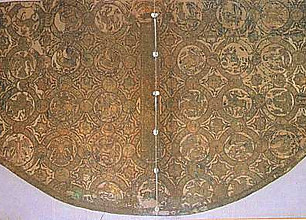
The chasuble of Thomas Becket, made in 1116

The Adoration of the Shepherds, Pieter Paul Rubens. Oil on canvas - Fermo, Pinacoteca Civica (Municipal art-gallery)
Fermo, Province of Fermo (Click here for map)
Fermo, the capital city of the province of Fermo, is an interesting town with splendid views from the top of the central hill. You can see over the fields to the mountains in one direction and as far as the ocean in the other.
Although there have been many Piceni artefacts found in the area, numerous human remains found in this area are funerary remains from the 9th–8th centuries BC, belonging to the Villanovan culture or the proto-Etruscan civilization.
The town itself became an important Roman colony, founded with 6,000 men in 264 BC, as the centre of Roman control of the region. It was called Firmum Picenum, and was situated at the junction of four major trading and military thoroughfares. The town passed into the control of the Vatican in the 8th century and then it became a free city in 1199. After this time a long period of war and strife continued with numerous attacks and occupations, until it was taken again by the Holy See in 1520. In 1861 Fermo became part of the province of Ascoli Piceno. The present Province of Fermo, with Fermo as its capital, was only established in 2009. There are many interesting buildings to visit, and Roman remains to be seen. There are some traces of a Roman amphitheater, but the most noteworthy Roman archaeological site is undoubtedly the Cisterns of Fermo. These consist of one of the most extensive and well-preserved examples of Roman cisterns in Italy. They consist of 30 underground rooms which provided water for the city, probably through public fountains. The underground pipe network above the cisterns was connected to a canal around the external walls. The cisterns are made of Opus Coementicium, which was a type of waterproofing concrete invented by Roman engineers.
There are, of course, many churches with interesting architecture and artworks to see. The first is the Cathedral, Santa Maria Assunta in Cielo in the Piazza del Popolo in the heart of the city. This Gothic façade also contains the historic library and the civic art gallery which holds The Adoration of the Shepherds by Pieter Paul Rubens (1608) among many other fine artworks. A few steps away stands the Teatro dell’Aquila, one of the most beautiful among at least one hundred plus historical theatres in Le Marche. The Cathedral has an interesting link with Britain. Among the possessions of the treasury is a chasuble said to have belonged to St. Thomas Becket, (often referred as Thomas à Beckett), who was murdered in Canterbury Cathedral in 1170 and canonized by Pope Alexander II on 1173.
The famous verse drama by T.S. Eliot ‘ Murder in the Cathedral’ (1935), and the film ‘Beckett’ (1964)(written by Jean Anouilh) both deal with his important role in British history and the Catholic church in England.
Aged 10, Becket was sent as a student to Merton Priory, and at 20 he spent a year in Paris; then he was sent to the university of Bologna to study canon law. In Bologna Becket shared a residence with a student named Presbitero, who later became archbishop of Fermo. The two young men became close friends, and probably carried on a correspondence, as, after Becket's murder, his mother sent Presbitero a keepsake, in the form of a precious cloak which had been embroidered in 1116 in the then Moorish Almeria, Spain. It was later given to the Diocese of Fermo by the Pope. The cloak, which had probably originally been a regal cape, is now stored in the Diocesan Museum of Fermo, located next to the cathedral.
St. Thomas Becket is very popular in the south of Le Marche: in Fermo a parish church is dedicated to him, and it was in this church that the cloak was found, after centuries lying undiscovered in a closed chest. A shrine, dedicated to St. Thomas Becket and located in the village of Montedinove (in the province of Ascoli Piceno) hosts relics of this English Saint, and he is solemnly celebrated every year on the date of his murder, 29th December.
Fermo offers visitors a unique attraction, namely the magnificent oil painting 'The Adoration of the Shepherds' by Rubens, currently exhibited in the Municipal Art Gallery of Fermo.This painting was commissioned for the church of St. Philip Neri in Fermo in 1608 by Father Flaminio Ricci in Rome, native of Fermo, Superior of the Oratorian order of Friars, and a great admirer of the young Flemish artist. This was Rubens’ final year in Italy.
On March the 9th, 1608, Rubens received a down-payment of 25 scudi and agreed to deliver the work within six months. He completed the painting before this time, and, on receiving a letter informing him of the serious illness of his mother, he left Italy, never to return.
The large canvas celebrates one of the most intimate and emotional moments of the Nativity, according to the Gospel of St Luke, with a composition showing a night time scene featuring glimmers of reflected light which subtly highlight the major figures, such as the holy Virgin, tenderly inclined over the Baby to whom she turns her loving gaze.
But a significant protagonist in the painting is the young shepherd in the foreground, in a reverential kneeling position and wearing a rich red garment.
It is clear from the magnificence of his limbs and the beauty of his countenance that he is inspired by classical heroic figures.
Knowledge of the existence of this artwork was handed down through the centuries only by local residents and it was unknown to major art critics, mainly due to its secluded location. Then, in the 1950’s, the contract with which it had been commissioned was discovered in Rome and this established official recognition of the work. However, as early as 1927 the great Italian art critic Roberto Longhi, on seeing the painting during a visit to Fermo, unequivocally identified the hand of Rubens, and was thrilled by the unexpected encounter. The original sketch, probably used to obtain the commission, is now housed at the Hermitage museum in Saint Petersburg, Russia.
Ripatransone, Province of Ascoli Piceno (Click here for map)
Click here for a heritage map of Ripatransone
Video Tour of Ripatransone and Surrounding Area
This fascinating, ancient, walled town sits high on a ridge overlooking the Tesino river valley, with a panorama of snow-capped mountains in the distance. In the height of summer it is the perfect place to visit to avoid the heat of the coast and lower-lying land. It is one of the oldest towns in the Piceno region, dating back to prehistoric times.
The warm pink brick of the ancient town walls are testament to the fact that the town has resisted all forms of modernisation. Given the small size of the town, the grandeur of the buildings is surprising, , with many dating back to the 16th century, when the town was given the status of ‘city’ and enjoyed great prosperity. The most famous feature of this lovely town is that it is the home of the narrowest alleyway in all Italy – only 43 cm wide!
There are a wealth of cultural and artistic delights to discover, including the medieval walls and towers, art galleries, and, of course, a variety of fine churches. There is also a magnificent theatre, constructed inside a 14th century Palazzo, and recently restored to its original mid-19th century glory. The food and wine from this region is also of a very high calibre, winning it membership of the prestigious ‘Citta’ del vino’ (wine city) club of Italy, which allows only 194 members from the whole of the country. It is also the recipient of the coveted ‘Orange flag’ seal for tourism and environmental quality.
Offida, Province of Ascoli Piceno (Click here for map)
Click here for a heritage map of Offida
The first thing that strikes you when approaching this hill-top walled town is the impressive Gothic-Romanesque church, Santa Maria della Rocca, perched high on a rocky outcrop at the edge of the town, surrounded on three sides by ravines. On a misty day the church seems to float over the town. This church contains some very striking frescoes dating from the 14th century.
The historical town centre is compact, and it is a joy to explore the atmospheric network of narrow streets lined with lovely old buildings and interesting shops and bars.
At the heart of it lies the interesting triangular piazza, which is the location of the biggest local festival, called the Bove Finto (the Fake Bull). This is a big annual festival with, at its heart, a bizarre ritual consisting of a group of volunteers carrying a large bull made of wood with which they carry out an entirely politically-correct bull fight! This town is famous for its wines – the most famous of which is Rosso Piceno, made of the Montepulciano grape.
A very important local industry, dating back to the 14th century, is lace-making, which is still carried out in the traditional way using bobbins, and the finished product is extremely intricate and beautiful. There are still many women here who continue the tradition, and you can watch them work and buy some of the intricate, elegant pieces of lace they produce. It is very labour intensive and takes many hours to produce one piece.
There is a market on Thursday where you can buy a wonderful range of local produce and take lunch ‘al fresco’ in the countryside, enjoying the spectacular views and marvellous local food.
Ascoli, Province of Ascoli Piceno (Click here for map)
Click here for a heritage map of Ascoli
Ascoli is the most important town in the south of the region. It lies at the confluence of two rivers, the Tronto and the smaller Castellano, and is bordered by two national parks. Its location is very significant as it lies not only on two rivers but on the ancient Via Salaria, or the Roman salt road that linked Latium with the salt producing areas on the Adriatic. However, the town has much more ancient origins. It was founded several centuries earlier by a branch of an Etruscan tribe called the Sabini. It remained proudly independent of Roman rule until eventually it fell, and was largely destroyed by Pompeius Strabo in 89 BC. It has had a colourful history, and during the Middle Ages was ravaged by the Ostragoths, and then ruled by the Franks. In 1189 it was declared a Free Republican Municipality, but internal strife prevailed right through until 1860 when it became a part of the Unified Kingdom of Italy.
It is quite a large and thriving town, but the picturesque old quarter, which stretches from the banks of the river Tronto to the main shopping street, Corso Mazzini, can easily be explored on foot.
The most striking aspect of this historically rich town is the stone from which it is built. This is unusual in the region, being the locally mined travertino, a porous, light-coloured stone that often has interesting patterns on the surface formed by ancient organisms living in the hot springs where it was formed.
The main square in the old town, the Piazza del Popolo, is commonly regarded as one of the most elegant in all Italy with its impressive 13th century ‘Palazzo del Popolo’, renaissance arcaded walkways and a splendid, if somewhat dour, Gothic church. The other main square, Piazza Arringo, is bordered by the Duomo or cathedral, adorned with an elaborate altar piece of the Madonna and saints, which is considered to be Carlo Crivelli’s finest work, and the Civic centre containing Ascoli’s main art gallery.
One of the many local events worth a visit is the festival of Saint Emidio (the protector of the city) on the first Sunday in August. More than 1500 local people dress in renaissance costumes and parade through the town, and this is followed by a kind of joust or tournament, called the Quintana.
Six knights on horseback, each representing a neighbourhood of the city, ride through a prepared course trying to hit an effigy of an Arab warrior! It is a very exciting spectacle.
It is also a great treat to swim with the locals in the smaller of the two rivers in the summer. There is a natural shallow pool, perfect for children, and waterfalls you can jump from into the clean, sparkling blue water. The town is also home to a very successful football team, Ascoli Picchio. This name refers to the Italian for a woodpecker (which also appears on the Ascoli flag) as this was the sacred bird for the original inhabitants, the Piceni.
Website: www.piceni.tv


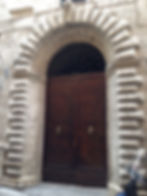

Ascoli


© Mariano Pallottini

© Mariano Pallottini

© Mariano Pallottini

© Mariano Pallottini













